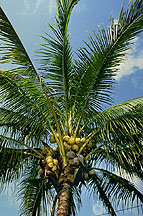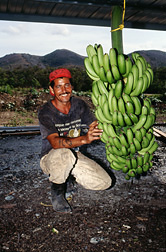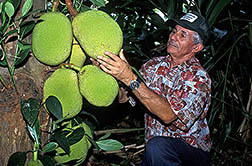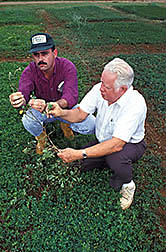|
|
Mayagüez Lab Helps Farmers in the Tropics
Mario Solar stands on his toes, reaching for a 100-pound banana bunch hanging from a plant on his farm at Salinas, in the southern coastal area of Puerto Rico. He cuts away the blue plastic bag that covers the bunch to minimize insect damage and increase yields. Then he pulls off five light-yellow bananas—four for his visitors and one for himself.
We are standing in what seems like a banana tree forest, dried leaves crunching under our feet, thankful for the shade under the foot-wide banana plant leaves in the 90° F air. The ground is dry, except where water has trickled from drip irrigation tubes, creating slippery puddles of mud.
It seems like a strange place to eat a banana: the morning breakfast table is a more familiar setting. But here we are, surrounded by plants so heavy with fruit they are tied to each other with orange twine to keep them from collapsing under their own weight. Here and there, a tree has toppled over nonetheless.
We each peel our bananas and take a bite as Soler awaits our opinion. The fruit is soft, sweet, and warm—the same temperature as the tropical air. We nod our approval.
"All my life I've been farming. I love it," Soler says, standing amid his 100 acres of fruits and vegetables, an agricultural oasis in an otherwise brown landscape.
|
|
In this semiarid south coast region, the average rainfall is only 30 to 35 inches a year—about half the average for Puerto Rico as a whole. Most of the rain in this area falls during a 3-month period from August through October. Now it is early June and the rain-fed riverbeds are dry.
That Soler and other farmers in Puerto Rico can grow a profitable crop in this dry region is largely due to their own hard work. But Soler is quick to give some of the credit to the man standing next to him. "Any problem I have, I call him and he helps me," says Soler of Heber Irizarry, an Agricultural Research Service horticulturist.
Irizarry points to the rows of Soler’s Grande Naine banana plants, which he and his colleagues in Puerto Rico introduced from Honduras in 1982. "You can see the uniformity of the bunches. It looks like a factory."
On this day we are seeing some of the best of Puerto Rico's food "factory," whose production has been driven by people like Irizarry and his colleagues at ARS' Tropical Agriculture Research Station in Mayaguez.
Since 1902, scientists there have been providing a research foundation for tropical agriculture, helping farmers more effectively grow bananas, plantains, sweet potatoes, yams, cassava, beans, grain sorghum, and other foods, such as tanier, or taro root.
They have introduced or developed improved varieties of these crops and have initiated and promoted efficient farming practices such as fertilization, drip irrigation, bunch pruning, bagging, and the management of banana plant shoots, called ratoons, that give growers an additional crop without replanting.
Scientists at the station have packaged these practices so that farmers like Mario Soler can produce a profitable crop.
"We try to give the farmer a crop and a system by which to grow it," explains station director Antonio Sotomayor-Rios.
Grande Naine is one of these success stories. In dry areas like the one where Soler farms, drip-irrigated Grande Naine plants can yield 56 metric tons of bananas per hectare (about 25 tons per acre). Growers are paid from $4.50 to $6.50 for a 40-pound box of high-quality bananas—meaning an acre could yield up to 1,250 boxes, or from $5,625 to $8,255 in gross revenue.
"There's no doubt that if they manage their crop carefully and irrigate, they can make a profit, even with the cost of installing a drip irrigation system," Irizarry says.
Plantains—A Major Crop
We are on our way to Isabela, in northwestern Puerto Rico, with Sotomayor-Rios and agronomist Francisco "Paco" Vazquez, who leads the station's germplasm project. In Puerto Rico, plantains are the second most important crop after coffee, with a farmgate value of just under $44 million.
Plantain fruits look like large bananas, but the pulp is not as soft. Green or ripe plantains can be fried, baked, or boiled, providing people on the island and other areas of the Tropics with a valuable source of carbohydrates and minerals.
A plantain called Maricongo accounts for about 90 percent of the crop grown in Puerto Rico. Although a high-quality plantain, Maricongo has inconsistent yields. By late 1995, Irizarry plans to release Superplatano, a plantain that—if managed properly—can have at least a 20 percent higher yield than Maricongo.
"Superplatano has great potential for export markets because its yields are consistent, and the size of the fruit is uniform if some of the lower hands of the bunch are pruned," he says. "It also has a softer fruit pulp than Maricongo, and it ripens like a banana."
We see our first fruiting Superplatano plants at Modesto Canabal's farm near Yauco in the southwestern region of the island. Most of the area, once in sugarcane, is now covered with bananas and plantains. Canabal is the first farmer on the island to grow Superplatano in test plantings. He is now harvesting fruit on 3 acres. And in early 1995, he plans to harvest an additional 12 acres that are under drip irrigation.
Irizarry believes the station's plantain research has been instrumental in increasing crop yields in Puerto Rico from 20,000 fruits per acre in the early 1970's to more than 40,000 today.
"In the 1970's, we pioneered the use of clonal selection in plantains and proposed techniques to overcome the problem of yield instability," he says. "From this program we released five superior clones after testing them all over the island, and these had an immediate impact on increasing yields and fruit quality."
Another plantain, called Lacknau, was found to have resistance to the corn weevil, a major banana and plantain pest.
We reach the lab's farm at Isabela and board a pickup truck that takes us into a field where workers are digging up sweet potatoes. There are several piles of roots on top of the soil. Their colors range from cream to dark purple.
"The purple variety, called Viola, averaged 38 metric tons per hectare (17 per acre) after 135 days in the field—a higher yield than any other sweet potato tested—before it was released in 1990," says station agronomist Edmundo Rivera.
Next to Viola is a pile of the cream-colored variety called Ivoire.
|
|
This is the final field trial of Ivoire before its release in 1995. Rivera says that aside from its high yield—comparable to Viola's—Ivoire has an unusual quality for a sweet potato: It isn't sweet. It is suitable for anyone who doesn't like the sweetness of a sweet potato but wants a good source of fiber and carbohydrates.
Nearby, Vazquez is growing yam plants on trellises, much like a backyard gardener would grow pole beans. Yams are tuberous vegetables, and the poles provide support for the heavy plant vines. But the trellises are also an added expense for farmers.
"Yams are usually grown on trellises in raised beds—meaning higher labor and materials costs." Vazquez says. "But our field experiments show that we can get 60 metric tons per hectare (27 per acre) on hilly land without trellises," he says.
|
|
Sotomayor-Rios says that "yams offer perhaps the greatest potential to offset food shortages in the Tropics, because some cultivars can be grown with no fertilizer." The station now has 24 yam cultivars from Southeast Asia, including two outstanding ones—Binugas and Gunung--that have high yields and resistance to leaf spot diseases, soil nematodes, and the tuber weevil.
Two tropical root crops, cassava and tanier, have also gotten a boost from ARS research at Mayaguez. Vazquez says that in the last 5 years, the station has screened more than 50 cassava varieties for yield and culinary quality. Three varieties that average 28 metric tons per hectare (12 per acre) without fertilizer are slated for release in 1995.
Tanier production is often plagued by disease, poor management, and other problems, according to plant physiologist Ricardo Goenaga. By properly managing soil, fertilizer, and drip irrigation, he says, growers can get 40 metric tons per hectare (18 per acre). One grower using Goenaga's methods is Carlos Hernandez, who planted 30 acres of tanier on his farm in Santa Isabel. Goenaga says growers like Hernandez can have a gross income of about $ 10,000 an acre using these production methods.
Other crops that have benefited from ARS research at the Mayaguez station are:
- Sorghum. One recent variety of forage sorghum released by the station is called Millo Blanco. It will grow up to 12 feet high and produce about 7 metric tons per hectare (3 per acre) of high-quality dry forage over a 2-month period. This is twice the yield of comparable varieties, Sotomayor-Rios says. It was developed for growing during both short and long days.
In cooperation with Texas A&M University, station researchers have released 533 converted sorghum lines through the Sorghum Conversion Program.
Through breeding, researchers convert plants that are sensitive to day length into ones that produce high yields, even when shorter winter days mean less light.
- Beans. More than 40 dry edible bean lines have been released from the Mayaguez station, making a major impact on bean production in the Tropics, says Phillip Miklas, a plant geneticist. One variety, Arroyo-Loro, is the leading bean grown in Puerto Rico. It is also a parent of Mayflower, which is grown on about 80,000 acres in Michigan alone. Miklas is now using genetic marker technology to transfer disease-resistance genes in bean germplasm.
- Cacao. In a cooperative project with the American Cacao Research Institute, Irizarry is evaluating 40 grafted clones selected from 5 hybrid families. The initial goal is to obtain a three- to four-fold increase in yields. He says it may be possible to intercrop cacao with plantains, since plantains can be grown side-by-side with young cacao plants, providing temporary shade for them and additional revenue for the farmer.
- Tropical fruit. Jackfruit, mangosteen, mango, avocado, lychee, mamey sapote, and carambola are some of the tropical fruits that Vazquez says have potential as alternative crops in Puerto Rico and elsewhere in the Tropics. One of the most promising of these fruits, mangosteen, is known as "the most delicious fruit in the Tropics," but can take from 8 to 15 years to bear fruit. Scientists at the station developed a way to graft it onto rootstock, allowing the tree to produce fruit within 3 to 5 years. — By Sean Adams, ARS.
Ricardo Goenaga is at the USDA-ARS Tropical Agriculture Research Station, 2200 P. A. Campos Ave., Suite 201, Mayaguez, PR 00680-5470, phone (809) 831-3435, fax (787) 831-3386; and Phillip Miklas is at the Vegetable and Forage Crops Research Laboratory, 24106 N Bunn RD, Prosser, WA, 99350-9687, phone (509) 786-9258, fax (509) 786-9277.
"Mayagüez Lab Helps Farmers in the Tropics" was published in the January 1995 issue of Agricultural Research magazine.












